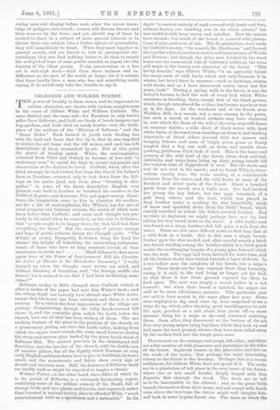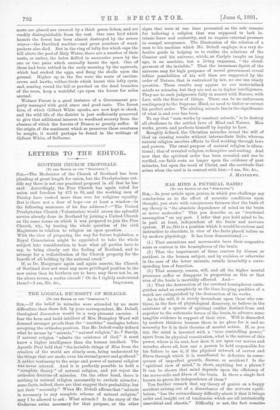SELBORNE AND WOLMER FOREST.
THE power of locality to form tastes, and its impotence to subdue character, are shown with curious completeness in the cases of Gilbert White and William Clobbett. The same district and the same soil—for Farnham is only twelve miles from Selborne, and both are lands of beech-hangers and hop-gardens, and both abut on sandy heaths—was the birth- place of the authors of the "History of Selborne" and the "Rural Rides." Each formed in youth such binding ties -with the land and those that live by it, that he was impelled to revisit the old home and the old scenes, and each has left descriptions of them unmatched by art. But at this point the power of locality ended. White, the contemplative, returned from Oriel and Oxford to become of free will "a stationary man," to spend his days in secure enjoyment and observation of the district he loved. Cobbett, when, after the third attempt, he had broken free from the ties of his father's farm at Farnham, returned only to look down from the hill- tops on his native land, and then, after "blessing it alto- gether " in some of the finest descriptive English ever printed, rode back to London to bombard his enemies in the Political Register, and denounce Pitt and paper-money. Some- times the temptation came to him to abandon his warfare, not for a life of contemplation, like White's, but for one of rural progress and business success, the seceet of which none knew better than Cobbett ; and some such thought was pro- bably in his mind when he remarked, on his visit to Selborne, that "people ought to be happy there, for that God had done everything for them," But the memory of private wrongs and hope of public reforms thrust the thought aside. "The delight of seeing Prosperity Robinson hang his head for shame I the delight ot beholding the tormenting embarrass- ments of those who have so long retained crowds of base miscreants to revile me I Shall Sidmouth then never again bear of his Power of Imprisonment Bill, his Circular, his Letter of Thanks to the Manchester Yeomanry 7 I really jumped up when the thought came across my mind, and without thinking of breakfast, said, 'Go, George, saddle the horses,' for it seemed to me that I had been meditating some crime I "
Selborne to-day is little changed since Cobbett visited .it after a reader of his paper had sent him White's book ; and the village itself can scarcely have altered since White wrote, except that his house has been enlarged, and there is a new rectory. To a visitor the first impressions of the village are perhaps disappointing, though the lofty beech-covered hill above it, and the romantic glen called the Leith, below the church, bear out all that has been written of them. The one striking feature of the place is the position of the church, on a promontory jutting out into this Leith valley, looking from which the square tower stands like some small fortress closing the steep and narrow glen, backed by the great beech-wood of Selborne Hill. The ancient yew-tree in the churchyard still flourishes, and the interior of the church, with its double row of massive pillars, has all the dignity which Norman or very early English architects knew how to give to buildings, however small, and the monuments and fabric show every sign of decent and reverent care. Still, the features of Selborne itself are hardly such as might be expected to inspire a classic. Wolmer Forest, on the other hand, three-fifths of which lie in the parish of Selborne, is a strangely fascinating region, containing some of the wildest scenery of the South, full of strange birds and rare plants and insects, and improved, rather than lessened in natural beauty, since it afforded White "much entertainment both as a sportsman and a naturalist." In his day it "consisted entirely of sand covered with heath and fern, without having one standing tree in its whole extent," but was studded with large meres and marshes. Now the waters have shrunk ; but much of the forest is covered with planta- tions of pine, and even of oak. The fir-plantations were made by Clobbett's enemy, "the smooth Mr. Huskisson," and formed the text for a ferocious attack on him as Commissioner of Woods and Forests; but though the price now fetched by the wood bears out the economical side of Cobbett's criticism, the trees add much to the beauty and character of the forest. "This lovely domain," says Gilbert White, "is an agreeable haunt for many sorts of wild fowls, which not only frequent it in winter, but breed there in summer,—such as lapwings, snipes, wild ducks, and as I have discovered within these last few years, teals." During a spring walk in the forest, it was the writer's fortune to find the nest of every bird which White mentions as breeding there, except that of the black grouse, which, though introduced for a time, has become nearly as rare as in his days. At the northern end of the forest, near Walldon Hill, is a marsh, not a mere swamp in the peats, but such a marsh as hunted outlaws may have sheltered in, over which the flame of the will-o'-the-wisp may still dance on summer nights ; a wide sheet of black water, with dead white limbs of drowned trees standing out from it, and winding labyrinths of dwarf alders covered with wet mosses and hanging lichens, and mats of bright green grass so firmly tangled that a boy can walk on them, and outside these quaking platforms thick beds of reed. This is the home and nursery of the wild fowl of the forest, where duck and teal, dabehicks and water-hens, bring up their young broods till the helpless time of flapperhood is over. But the ducks and teal do not nest in the marsh ; and we found White's obser- vations exactly true, the teals nesting at a considerable distance from the water, and the wild ducks in some of the furthest and driest parts of the forest. About a hundred yards from the marsh was a teal's nest. She had hatched her young the day before, but two eggs remained, of a pale ivory colour, and the xtest, which was placed in deep heather under a seedling fir, was beautifully made of moss and speckled down from the birds' breast, which exactly matched in colour the lichen-covered heather. Had we risen at daybreak, we might perhaps have met the bird taking her tiny brood down to the water. A wild duck's nest was found on a steep, heather-clad hill quite a mile from the water. There are few more difficult nests to find than that of a wild duck on a heath. But in this case a single breast- feather gave the clue needed, and after careful search a track was found winding among the heather-stems to a thick patch under the overhanging boughs of a young pine, beneath which was the nest. The eggs had been hatched for some time, and all the broken shells were buried beneath a layer of down. In a wet hollow near the outskirts of the forest, was a snipe's nest. These birds are far less common there than formerly, owing, it is said, to the turf being no longer cut for fuel, so that there is less fresh ground exposed for them to feed upon. The nest was simply a round hollow in a wet tussock ; but when their brood is hatched, the snipes are said to be most affectionate parents. This particular pair are said to have nested in the same place last year. Some men employed to dig sand close by, were surprised to see a snipe fly up, which, after showing great unwillingness to quit the spot, perched on a rail about four yards off —a most unusual thing for a snipe to do—and remained watching them. Soon after, they discovered at the bottom of the pit four very young snipes lying together, which they took up and laid upon the level ground, whence they were soon called away by the mother-bird into the rough grass near.
Plovers nest on the swamps and rough hill-sides ; and there are a fair number of wild pheasants and partridges on the sides of the forest. Squirrels swarm in the pine-trees, and live on the seeds of the cones. But perhaps the most interesting colony in the forest is the heronry. Perhaps this is a recent settlement, for Gilbert White does not speak of it. The nests are in a plantation of tall pines in the very heart of the forest, where one or two small brooks, deeply tinged with iron deposits, flow through the wood. The trees are so tall as to be inaccessible to the climber ; and as the great birds Launch themselves from their nests, and sail round with harsh cries above the tree-tops, the visitor might well imagine him- self back in some bygone forest era. The trees on which the nests are placed are covered by a thick green lichen, and are readily distinguishable from the rest. One rare bird which haunts the forest has been almost destroyed by the severe winter—the Dartford warbler—and great numbers of wood- peckers also died. But in the ring of lofty firs *hich caps the hill above the pool of Holy Water, there are a number of their nests, or rather, the holes drilled in successive years by the one or two pairs which annually haunt the spot. One of these had been robbed in the early morning by the squirrels, which had sucked the eggs, and flung the shells upon the ground. Higher up in the firs were the nests of carrion- crows and hawks, robber-birds which haunt this lofty eyrie, and, soaring round the hill or perched on the dead branches of the trees, keep a watchful eye upon the forest for miles around.
Wolmer Forest is a good instance of a Government pro- perty managed with good sense and good taste. The forest fires, of which Gilbert White speaks, are now kept in check, and the wild life of the district is just sufficiently preserved to give that additional interest to woodland scenery from the absence of which the forests of France so greatly suffer. If the origin of the sentiment which so preserves these creatures be sought, it would perhaps be found in the writings of Gilbert White, of Selborne.







































 Previous page
Previous page